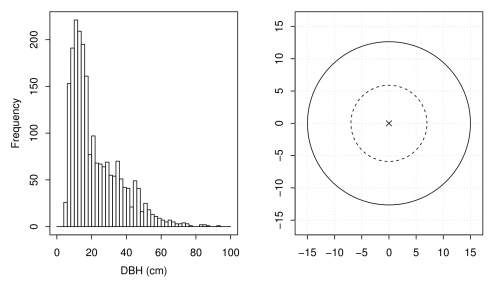Resource assessment exercises: nested fixed area plots
| sorry: |
This section is still under construction! This article was last modified on 07/23/2014. If you have comments please use the Discussion page or contribute to the article! |
In the last subsection we saw that we “measured” 2,158 DBHs on the \(n=50\) fixed area plots. Many of the trees are relatively small, i.e., have small DBHs. Figure A shows a histogram of the variable dbh. The bin width is two centimeters.
bins <- seq(from=0, to=100, by=2) # define bin wiedth (here, 2 cm classes) hist(fixed.area$dbh, breaks=bins, main="", xlab="DBH (cm)")
 What the function
What the function seq()does- The function
seq(from, to, by)creates a sequence of values. The argumentbydefines the step length. Alternatively you can use, e.g.,length.out. For exampleseq(0, 1, length.out = 10)} creates a sequence from zero to one of length 10.\par
We use the quantile() function to obtain a numerical representation of the DBH distribution.
quantile(fixed.area$dbh, probs=seq(from=0, to=1, by=0.1)) ## 0% 10% 20% 30% 40% 50% 60% 70% 80% 90% 100% ## 6 9 11 13 15 17 22 28 35 45 93
 What the function
What the function quantile()does- The function
quantile(x, )provides sample quantiles for given probabilities (argumentprobs). The probabilities have lie between zero and one, i.e., [0, 1].
We see that many trees have a DBH below 15 cm. Measuring all the DBHs on a plot is often a tedious task. Moreover, small trees contribute relatively little to the BA ha\(^{-1}\). Can we reduce the number of small trees we need to measure?
In forest inventories nested plots are frequently used (see Figure [fig:hist]). Within the larger area (solid line) all trees with a DBH larger than 15 centimeters are measured, and small trees (\(\leq\)15 cm) are only recorded within the smaller circle (dashed line). The radius of the smaller plot is \(r_{\text{small}}=7.73\) and for the larger we still use a radius of \(r_{\text{large}}=15.45\).
We file MES.RData contains a data.frame named nested. The locations of the plots are exactly the same as for the fixed.area plots. However, we used a threshold diameter for small trees (\(\leq\)15 cm) in a nested plot design.
Here are the number of trees we measured.
## [1] 1624
## [1] 2158
Using the nested plot design we reduced the number of measured DBHs by 534. Does it reduce the precision of the BA ha\(^{-1}\) estimate considerably?
Firstly, we need to calculate the BA for each tree again. Secondly, we need to calculate the expansion factors for the larger and smaller nested plot.
## [1] 15.45
## [1] 7.725
## [1] 187.5
Thirdly, the BA per hectare and plot is calculated for the large and small plots and multiplied with the respective expansion factor.
Finally, we sum up the BA ha\(^{-1}\) for large and small plots.
'
The error message is printed because there are small plots that do not contain any trees, i.e., bal and bas do not have the same length. Here is a simple workaround.
Next, we compute the mean of the BA ha\(^{-1}\) per plot to estimate the population BA ha\(^{-1}\).
## [1] 34.62
Finally, we construct the confidence intervals around our estimated mean.
## [1] 3.245
## [1] 9.376
## [1] 6.522
## [1] 28.09
## [1] 41.14
Exercises
Repeat the tasks from the last exercise (Section [sub:fixedex]). Use the data in nested.Ex. Trees with a DBH \(\leq\) 15 cm have only been measured within a smaller circular plot with \(r=10\) meters.
